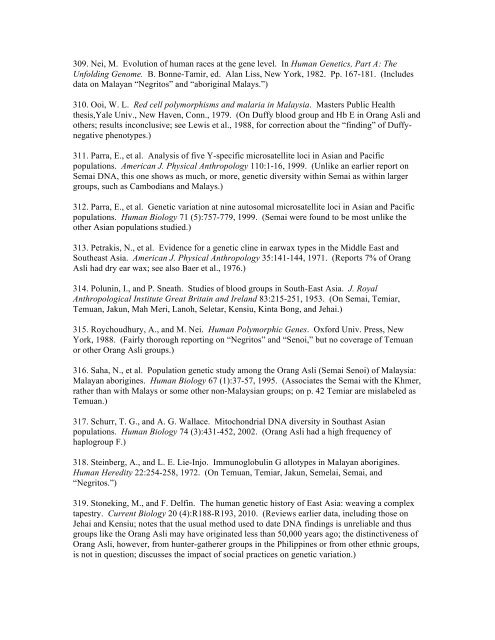Orang Asli (Indigenous Malaysian) Biomedical Bibliography AS Baer
Orang Asli (Indigenous Malaysian) Biomedical Bibliography AS Baer
Orang Asli (Indigenous Malaysian) Biomedical Bibliography AS Baer
You also want an ePaper? Increase the reach of your titles
YUMPU automatically turns print PDFs into web optimized ePapers that Google loves.
309. Nei, M. Evolution of human races at the gene level. In Human Genetics, Part A: The<br />
Unfolding Genome. B. Bonne-Tamir, ed. Alan Liss, New York, 1982. Pp. 167-181. (Includes<br />
data on Malayan “Negritos” and “aboriginal Malays.”)<br />
310. Ooi, W. L. Red cell polymorphisms and malaria in Malaysia. Masters Public Health<br />
thesis,Yale Univ., New Haven, Conn., 1979. (On Duffy blood group and Hb E in <strong>Orang</strong> <strong>Asli</strong> and<br />
others; results inconclusive; see Lewis et al., 1988, for correction about the “finding” of Duffynegative<br />
phenotypes.)<br />
311. Parra, E., et al. Analysis of five Y-specific microsatellite loci in Asian and Pacific<br />
populations. American J. Physical Anthropology 110:1-16, 1999. (Unlike an earlier report on<br />
Semai DNA, this one shows as much, or more, genetic diversity within Semai as within larger<br />
groups, such as Cambodians and Malays.)<br />
312. Parra, E., et al. Genetic variation at nine autosomal microsatellite loci in Asian and Pacific<br />
populations. Human Biology 71 (5):757-779, 1999. (Semai were found to be most unlike the<br />
other Asian populations studied.)<br />
313. Petrakis, N., et al. Evidence for a genetic cline in earwax types in the Middle East and<br />
Southeast Asia. American J. Physical Anthropology 35:141-144, 1971. (Reports 7% of <strong>Orang</strong><br />
<strong>Asli</strong> had dry ear wax; see also <strong>Baer</strong> et al., 1976.)<br />
314. Polunin, I., and P. Sneath. Studies of blood groups in South-East Asia. J. Royal<br />
Anthropological Institute Great Britain and Ireland 83:215-251, 1953. (On Semai, Temiar,<br />
Temuan, Jakun, Mah Meri, Lanoh, Seletar, Kensiu, Kinta Bong, and Jehai.)<br />
315. Roychoudhury, A., and M. Nei. Human Polymorphic Genes. Oxford Univ. Press, New<br />
York, 1988. (Fairly thorough reporting on “Negritos” and “Senoi,” but no coverage of Temuan<br />
or other <strong>Orang</strong> <strong>Asli</strong> groups.)<br />
316. Saha, N., et al. Population genetic study among the <strong>Orang</strong> <strong>Asli</strong> (Semai Senoi) of Malaysia:<br />
Malayan aborigines. Human Biology 67 (1):37-57, 1995. (Associates the Semai with the Khmer,<br />
rather than with Malays or some other non-<strong>Malaysian</strong> groups; on p. 42 Temiar are mislabeled as<br />
Temuan.)<br />
317. Schurr, T. G., and A. G. Wallace. Mitochondrial DNA diversity in Southast Asian<br />
populations. Human Biology 74 (3):431-452, 2002. (<strong>Orang</strong> <strong>Asli</strong> had a high frequency of<br />
haplogroup F.)<br />
318. Steinberg, A., and L. E. Lie-Injo. Immunoglobulin G allotypes in Malayan aborigines.<br />
Human Heredity 22:254-258, 1972. (On Temuan, Temiar, Jakun, Semelai, Semai, and<br />
“Negritos.”)<br />
319. Stoneking, M., and F. Delfin. The human genetic history of East Asia: weaving a complex<br />
tapestry. Current Biology 20 (4):R188-R193, 2010. (Reviews earlier data, including those on<br />
Jehai and Kensiu; notes that the usual method used to date DNA findings is unreliable and thus<br />
groups like the <strong>Orang</strong> <strong>Asli</strong> may have originated less than 50,000 years ago; the distinctiveness of<br />
<strong>Orang</strong> <strong>Asli</strong>, however, from hunter-gatherer groups in the Philippines or from other ethnic groups,<br />
is not in question; discusses the impact of social practices on genetic variation.)















